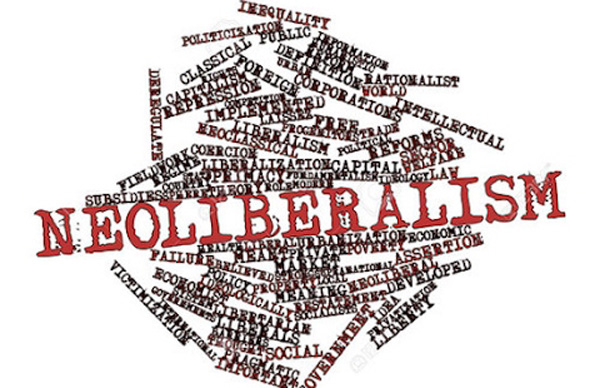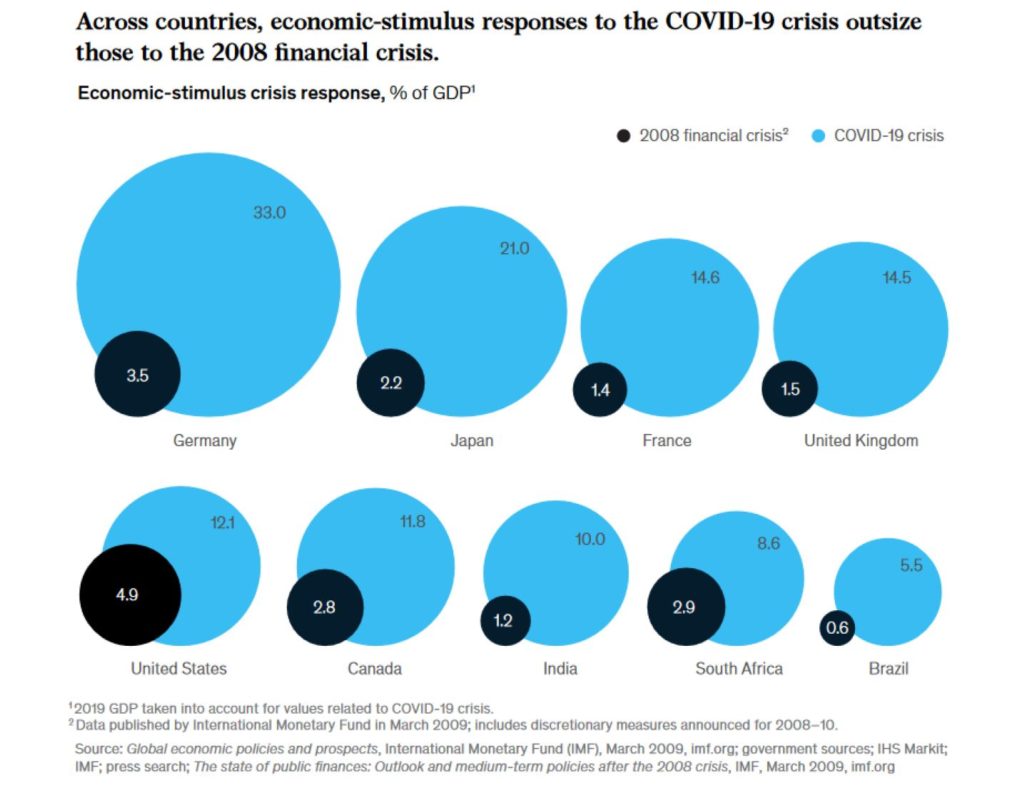We publish below the fourth part of the documents concerning the “neoliberalism debate” that took place in the ISA. This is the document of comrade GK from the German section who had an independent position, circulated on July 2020.
To get the general picture for this debate, read our introduction to the publication of this material here.
You can also read the previous documents:
– Majority positions of May 2020 here.
– Minority positions of May 2020 here.
The second part of the debate:
– Majority positions of July 2020 here.
– Minority positions of July 2020 here.
The third part of the debate:
– Majority positions of November 2020 here.
– Minority positions of November 2020 here .
Main features of the new era
A contribution to the discussion on Neoliberalism, Keynesianism, Consciousness Georg K Germany, July 2020
We all agree that a new era is opening up. What will be the key features of the new era? How can it be defined?
Obviously an old era must come to an end in order to correctly speak about a new era.
Tom and Eric use the formulation “end of the neoliberal era”. Looking from a class standpoint neoliberalism benefited the interest of the capitalist class and was an attack on the interests of the working class. There are two major problems if we use the term or discription “The end of neoliberalism”. It can create the wrong impression, that the dominating policy, neoliberalism – a negative thing for the working class, is now replaced by something ‘better’.
Tom and Eric clearly state, that this is not what they want to say. “We should underline that what is meant is the end of the neoliberal era or phase of world capitalist history. We don’t mean this is the end of all neoliberal policies such as privatization and deregulation. We certainly don’t mean that this is the end of austerity and attacks on the working class which is a feature of every capitalist crisis as the ruling class seeks to make the working class shoulder the cost. (ISA IMB #10 Page 5)
There is no contradiction in the various formulations describing neoliberalism given so far in the written contributions of the different comrades. Neoliberalism is a set of of economic policy measures. This is accompanied and justified by ideological doctrines.
Which of the economic policy measures will be partly or completely reversed and which of the ideological doctrines will be undermined or no longer used by the ruling class in the course of the crisis?
To begin with the easiest thing: Yes, based on the experience of the past years and very much reinforced by the current crisis, the ideology of neoliberalism has been severely undermined and discredited in the minds of the masses. In terms of ideology neoliberalism is severely damaged. Therefore the capitalist can not go on with the same argumentation.
But will they go on with the same policies? No, they can’t. There must be qualitatively more state intervention to keep their system going. We witness public spending and public debt on a global scale never seen before.
The capitalist are confronted with a simple but dire question: where to invest their money and get it back with a certain profit? Public spending financed by public debt can partly and temporarily solve this problem, because to a certain extent it keeps the economy going.
In this aspect there will be the clearest turn away from neoliberal policies. But this will not be enough to solve the “crisis of profitability”. And it will not solve the contradiction between production on a world scale and for the world market in the narrow limits of the nation state.
Therefore on most of the other aspects of neoliberalism, it will be much more contradictory. There will be the need for further privatization to open up new fields for private investment at the same time there will be the need for nationalization or partly nationalization to rescue key industries or companies from bankruptcy or foreign take over. There will be more regulation and deregulation at the same time. Examples for these contradictory elements have been given in the contributions of the Greek IC and by Vlad, Rob, Viki. As far as I understand, no one is denying this.
For all these reasons the formulation “end of the neoliberal era” will not help to clarify things. Therefore we should not use it.
It will take some time and it will afford new formulations to define this new era we are entering and the main features of bourgeois policies in this era. Of course we should not just wait and see in trying to describe this new era. But there is a difference in trying to describe the contradictory aspects and or trying to press it in a fixed formula.
What has come to an end?
In economic terms the capitalist crisis is a crisis of over-accumulation of capital. This was already the cause of World War I. The crisis of the 1930 was “solved” by World War II. The crisis in the beginning 1970s that ended the post war boom, was partly and temporarily overcome by the turn to neoliberalism. Without capitalist restoration since 1990 there would have been a major crisis much earlier. Capitalist restoration opened up new opportunities to invest capital and therefore to further delay the crisis of over-accumulation and profitability. The exceptional effects of capitalist restoration have lost more and more of their impact, in fact they turned into their opposite, they aggravated the problem of over-accumulation of capital.
An important turning point was the crisis of 2008/09. Independently of the current debate I have tried to study the new phase of imperialism in the 21st century on the basis of several economic facts in a separate document. The text can be found here: Imperialism-and-War-in-the-21th- Century
On an international level the growing tensions between the different powers will be the most important feature of the crisis. These tensions will result in different steps of ‘cold’ war and towards real wars. We have already said that. We all agree on that. I would just like to stress one point: During this crisis some countries will be hit and weakened more than others, they will fall back, others will rise relatively to them. This process was already underway but will be enormously accelerated through this crisis. We will see intensified rivalry not only between the main imperialist powers but between the regional powers as well. Of course both processes are linked together.
Features of the new era will be
- a rise in mass-unemployment and in mass poverty
- a fall in the living standard for most parts of the working class
- the young generation will be hit especially hard
- the gap in society between rich and poor will deepen
On an international level
- the rivalry between the imperialist powers will intensify
- the gap between the richer and poorer countries will deepen
- all kinds of international conflicts – political, economic, military – will increase, political instability will increase
- military expenditure will increase
- there will be more refugees, fleeing from poverty, political persecution, destruction of the environment and from war
This has already been stated in our documents in one form or another. The question we are discussing is: how will the capitalist class and their state react to the crisis?
Problems in using the term “Keynesianism”
The use of the term Keynesianism is in a way problematic, too. The term is widely unknown in the working class. It is used in the political left, but in a rather confusing way. John Meynard Keynes developed his theory at the beginning of the 1930s. In order to overcome an economic crisis, the state should spent money on public investment such as the construction of roads, railways or public buildings, or indirectly, e.g. through tax concessions for private investments. During the crisis the state should do deficit spending and then reduce the debt during the upswing by raising taxes.
Part one of his theory – state expenditure, state investment – was applied mainly in the US in the 30s in form of the New Deal. As we know that crisis was only ‘solved’ by World War II. But the idea of Keynesianism still has many supporters among left-wing reformists today. They mistakenly refer to the form of state interventionism during the post-war boom as Keynesianism. We all agree that in front of us there is not a phase of prolonged capitalist upswing but a dramatic crisis that in no way can be solved smoothly. Contradictory measures will be taken.
Under this circumstances to speak about ‘Keynesianism’, ‘neo-Keynesyanism’, ‘military Keynesianism’ will not really be helpful to clarify things.
Different forms of state interventionism
There will be more state interventionism, we all agree on that. But what form will it take and how far can it go?
This will depend on the depth of the crisis, on the resources at the disposal of the capitalists and last but not least it will depend on the class struggle.
The following chart may illustrate the extent of state intervention in form of stimulus or rescue packages already applied in this crisis compared to 2008/09.
These figures are from June 2020 produced by McKinsey and for reasons I don’t know they do not include China, but they are still interesting.
In the text accompanying it the authors state about the economic-stimulus measures in 2020:
“countries with liberal-market economies [USA, GB, Canada, Australia] have provided approximately 60 percent of total relief measures in direct value transfers and loans, compared with only around 10 percent in countries with coordinated-market economies [Austria, Denmark, Finland, Germany, the Netherlands, Sweden, and South Korea], which have spent around 80 percent of stimulus measures on guarantees.“
This figures hint to two interesting questions: what part of the state expenditure will in some kind benefit the working class? And what part is real state investment compared to just spending money? That would mean state investment in the sense that the state tries to steer investments by acting as an investor itself or by linking its funding to specific investments. The state can, for example, directly assign public contracts for the construction of schools or it can support private companies investing in new technologies. In my impression, at this moment in time, the state limits itself mainly to simply providing money. This can of course change later, when it becomes clear that this does not lead to the expected results.
In my opinion, we have underestimated the possibilities of the capitalists. The material resources at hand are incomparably greater today than they were after World War I and II. There are no absolute limits to capitalism. Faced with mass movements or even upheavals in an important country, the capitalists might be ready to make even bigger concessions that seem impossible today. On the other hand, there can be no capitalism in which helicopter money is distributed endlessly. It has to be said again, the measures that will be taken, will be contradictory. Governments my introduce higher taxes for the rich at the same time reducing taxes for companies. On the one Hand introducing public work schemes and on the other hand cutting jobs in public services.
On globalization
There will be further tendencies towards de-globalization. This is undisputed. Apart from the facts other comrades have already provided and apart from the figures in my text on imperialism mentioned above, I would like to add the following charts on the development of world trade, Foreign Direct Investment (FDI) and on International Investments Agreements (IIAs) without commenting on that. They show the extent of globalization and the latest problems as well. For more information see Imperialism-and-War-in-the-21th-Century.
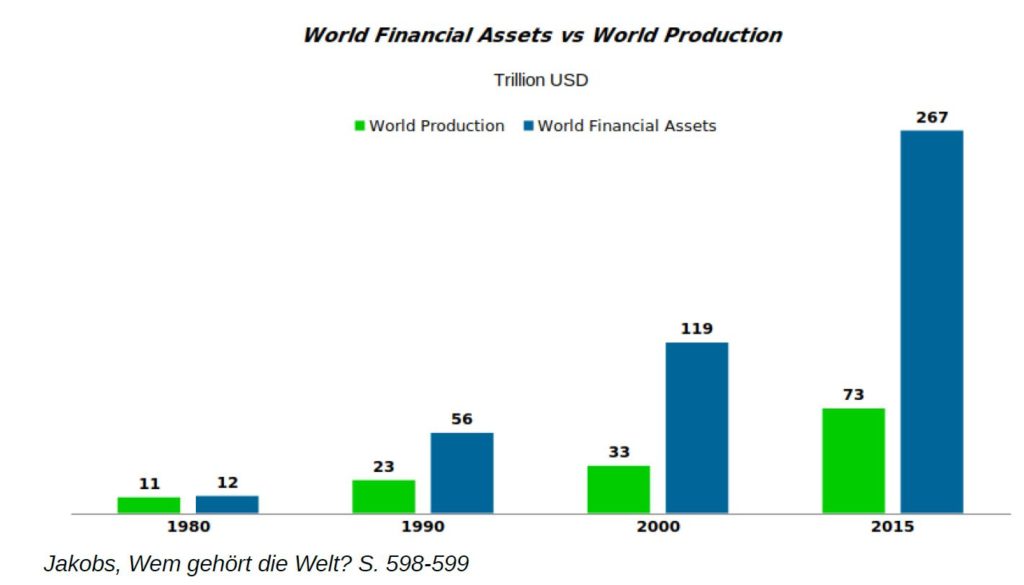
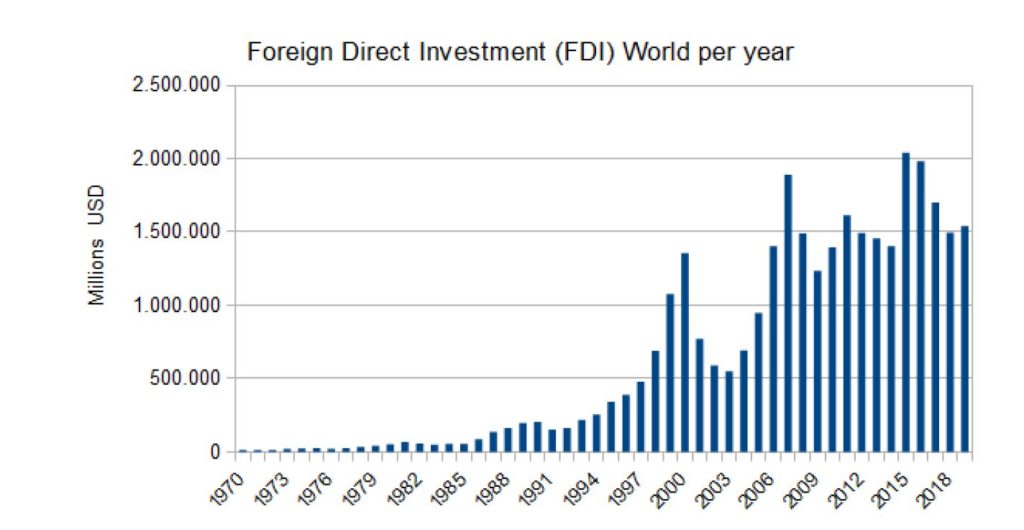
Inward flow, excluding the offshore financial centres in the Caribbean
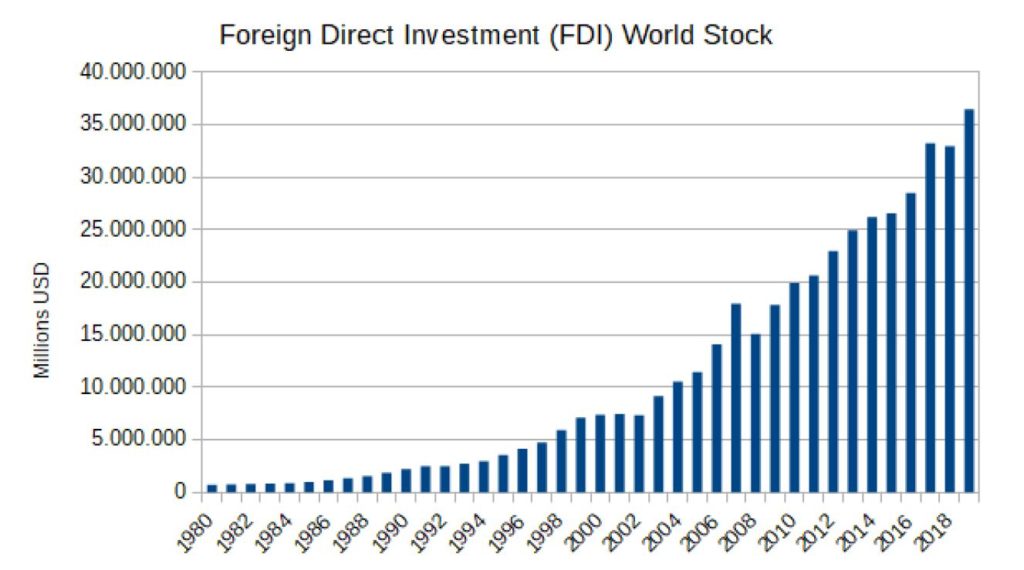
Stock, inward, excluding the offshore financial centres in the Caribbean
Chart says: In 2019 the world stock of foreign direct investment was more then 35 trillion USD. Note: The world stock in portfolio investment (reported portfolio investment assets) is even higher: 55 Trillion USD in 2019. IMF
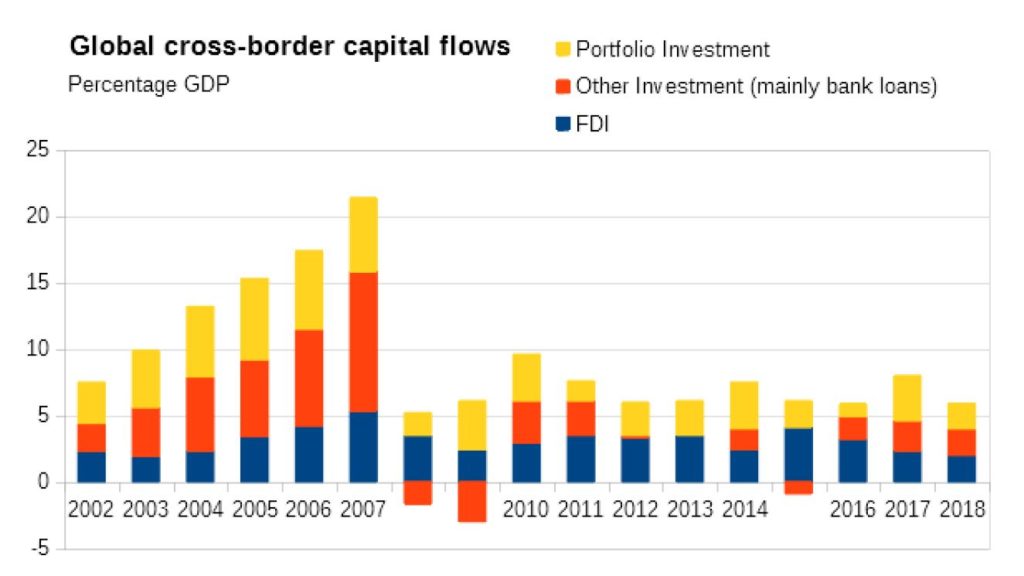
World Trade:
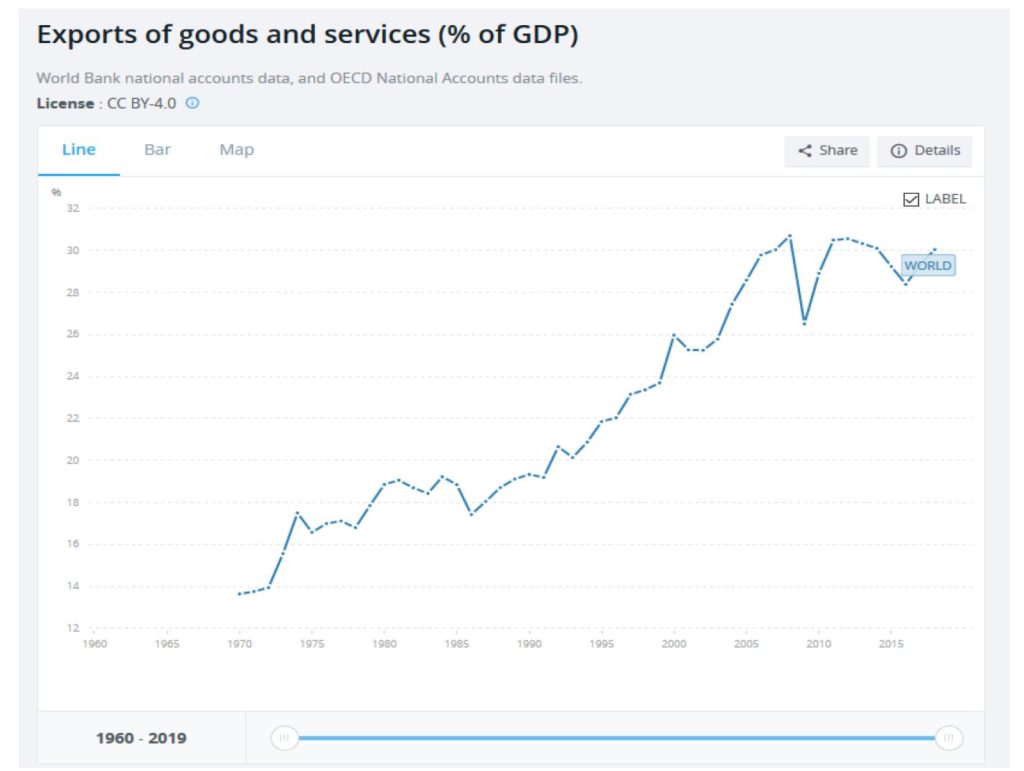
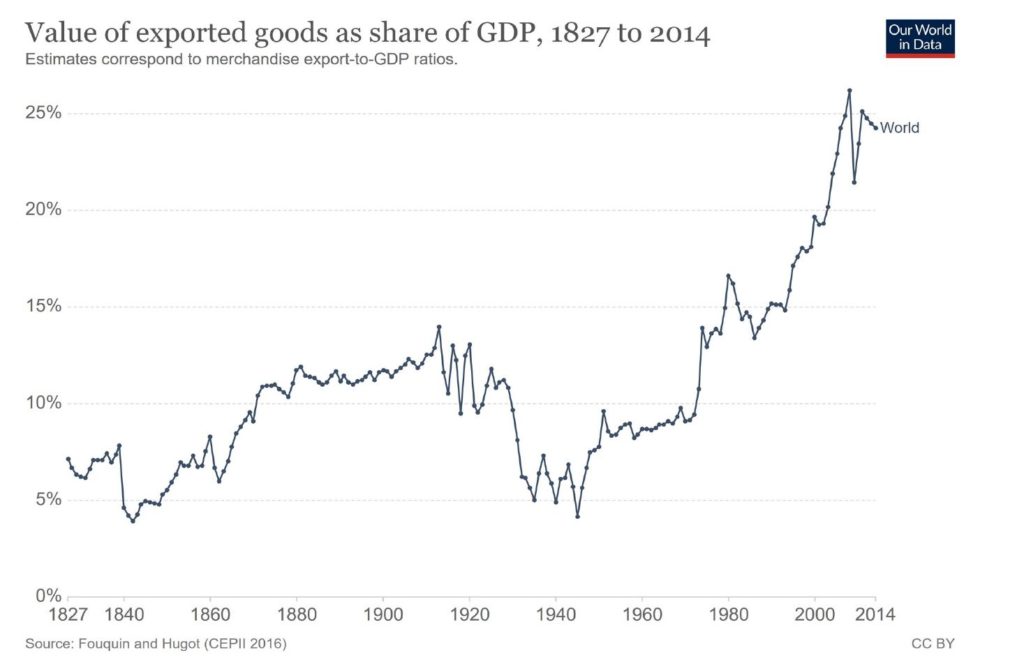
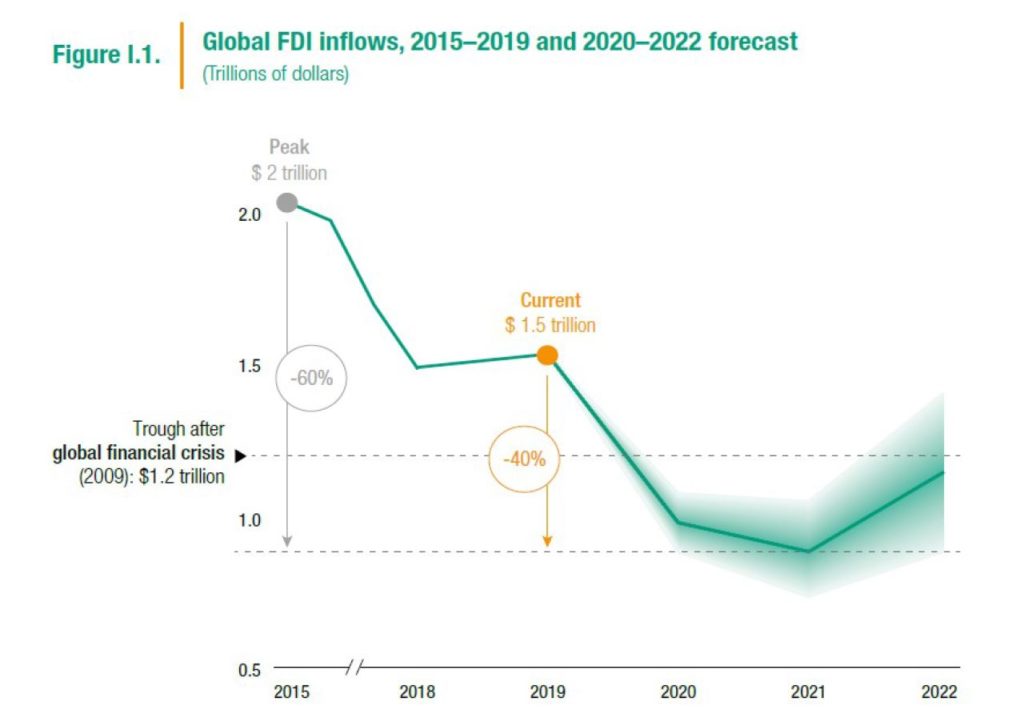
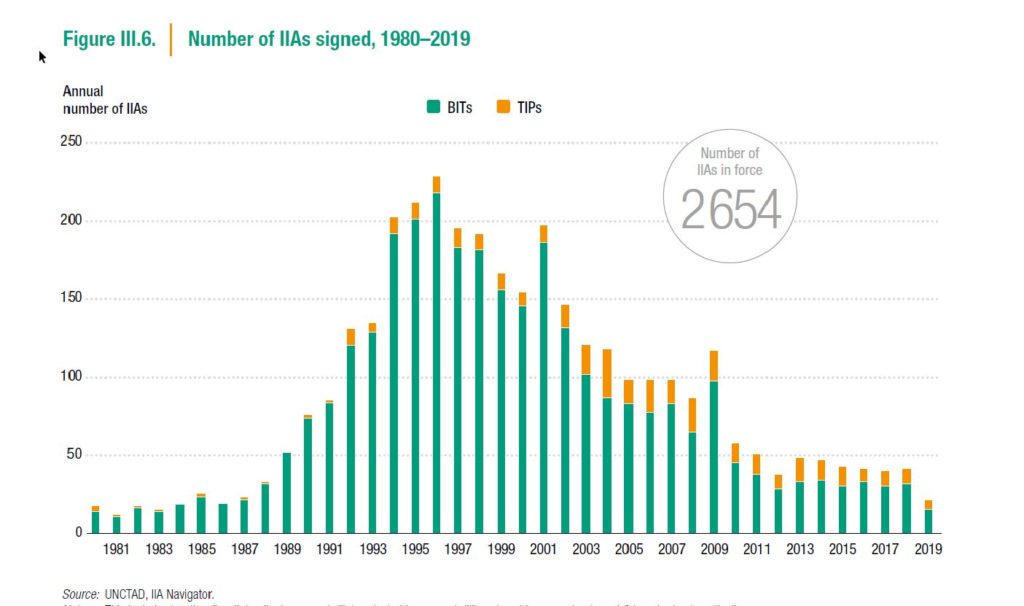
Obviously capitalist globalization is no longer expanding. It came to a halt and is even shrinking. The main trend will be less globalization but the capitalists can not even half way go back to the times of the 1970s with a very limited cross border flow of capital. Just one example to illustrate this: the leading German bank, the Deutsche Bank in 1976 in London opened its first! foreign office after World War II. In 2016 Deutsche Bank had more than 800 foreign offices in over 50 countries. Comrades Vlad, Rob and Viki already hinted at the fact of the international integration of supply chains and production (See IMB ‘10). Again just one example about the car industry: (Figures from 2016)
International integration reached a point where six of the ten largest car manufacturers produce more in other countries than in their home country:
- VW, in 2nd place, produces more cars in China (38%) than in Germany (27%)
- Hyundai in 3rd place produces more vehicles in China, the USA, India, Brazil and Mexico than in its home country South Korea
- GM, rank 4, produces more cars in China and Mexico alone than in the USA
- Ford in fifth place produces significantly more cars in China, Germany, India, Brazil, Mexico, Spain and Canada than in the USA
- Nissan, the number 6, produces more cars in China and the USA than in its home country Japan
- Honda, in 7th place, has more production in the USA than in Japan. quest-trendmagazin.de
I would like to refer comrades once again to my text on imperialism in the 21st century. It contains more facts and conclusions from it.
On consciousness and the balance of power in the class struggle
How far and how quickly can the capitalists impose the burden of the crisis on the working class? What share might they have to take themselves? That, of course, depends crucially on the balance of power in the class struggle. As already has been said, today there is neither an alternative system to capitalism nor strong workers’ parties nor a socialist consciousness. But on the positive side is the numerical strength of the working class, which is qualitatively stronger today in absolute numbers and in its share of the population than ever before. Moreover, the capitalists have understood that a local revolt can spread across the globe at the speed of a Twitter message. Being aware that political earthquakes can occur at any time, they try to avoid shocks as long as possible.
I agree with the Greek IC that in the World Perspectives Update – May 2020 there are several exaggerations concerning the role of the working class “in its response to the pandemic” and on the present consciousness in general.
One of the disputed sentences in this debate is that of the Greek IC saying “Consciousness in the period of the corona virus is a much more complicated issue than in the course of the 2008-9 crisis. “ The Greek comrades argue that in Greece “In 2010 society was raging with anger, with millions out on the streets. The enemy was clear, it was the government, the IMF, the EU, the Troika.” And that this was not only true for Greece. (See IMB #8). Tom and Eric argue that all the bitter experiences since the 2008/09 crisis, the revolts especially seen in 2019 and now the experiences in the context of the corona virus have had an impact on the consciousness of the masses.
I believe that this controversy can be solved. I think it would be more correct to say: “Consciousness in the period of the corona virus is in one aspect a much more complicated issue than in the course of the 2008-9 crisis.“ The fact that the virus can be presented as the cause of the crisis is one factor that makes it more difficult to recognize the true, capitalist, cause of the crisis.
Not only but also in the sense that ‘conditions determine consciousness’ the experiences and struggles of the last years and this new crisis of course have had an important impact on consciousness. In this context I would like to stress that because of the international character of the crisis in economic, political and environmental terms, a kind of an international awareness, international struggle and consciousness of global problems has developed over the last years among workers and youth all over the world. This is true despite many differences in the respective situation in different countries.
If we take into account all aspects of this discussion and bring them together, we are well positioned to take advantage of the opportunities that we have in the current situation to build our forces.


